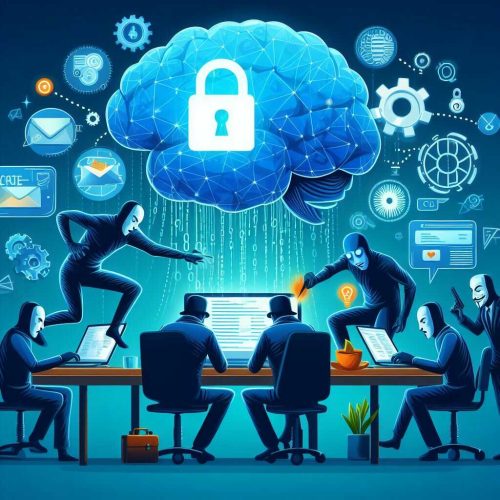Step into the digital battlefield, where the stakes are higher than ever. In a world where every click could mean disaster, cybersecurity stands as our shield against unseen dangers. Join us on a journey through the labyrinth of cyber threats, from the cunning tricks of phishing to the deceptive whispers of vishing. In this gripping guide, we’ll reveal the secrets to fortifying your defenses, protecting your treasures, and arming yourself with the knowledge needed to outsmart the lurking shadows of cybercrime related to phone calls, texting, WhatsApps, Email and more.
WhatsApp and phone vishing attacks significantly threaten our digital security and personal privacy. By understanding the tactics used by cybercriminals and implementing proactive measures to safeguard ourselves, we can mitigate the risk of falling victim to these malicious schemes. Remember, vigilance and awareness are our most robust defenses in the ever-evolving landscape of cyber threats. Stay informed, stay secure, and protect yourself and your loved ones from the dangers of vishing attacks.
Moreover, Phishing remains a persistent threat in the digital landscape, with cybercriminals continuously devising sophisticated tactics to deceive unsuspecting individuals. These attacks typically involve fraudulent emails or messages that mimic reputable organizations, luring recipients into divulging sensitive information or clicking on malicious links. Whether through enticing offers, urgent warnings, or false promises, phishing preys on human vulnerability, aiming to exploit trust and manipulate users into compromising their security. It’s imperative to remain vigilant and equipped with knowledge to recognize and thwart phishing attempts, safeguarding personal and organizational data from potential harm.

Vishing, short for “voice phishing,” is a social engineering attack where cybercriminals use voice calls to deceive individuals into divulging sensitive information or performing actions that compromise their security. With WhatsApp being one of the most widely used messaging platforms globally, it’s no surprise that cybercriminals have turned their sights on exploiting its popularity.
These tactics and phishing represent two of the most prevalent and dangerous cyber threats facing individuals and businesses today. While phishing involves using deceptive emails, messages, or websites to trick victims into divulging sensitive information such as login credentials, financial details, or personal data, vishing leverages voice calls or voice-over-internet-protocol (VoIP) technology to manipulate victims into revealing confidential information or performing unauthorized actions.
Unveiling the Tactics of Vishing and Phishing Attacks:
A vishing attack starts with a cunning cybercriminal constructing a convincing phone call or voice message, masquerading as a trusted entity. Similarly, in a phishing attack, deceptive emails or messages are skillfully crafted, often replicating the branding and tone of reputable organizations. These communications typically instill a sense of urgency or offer enticing rewards, coercing recipients into immediate action. Once lured into the trap, victims unwittingly engage with malicious content, jeopardizing their personal or corporate data. The consequences can be dire, ranging from financial loss and identity theft to unauthorized access to critical systems. Stay informed to outsmart these deceptive maneuvers and safeguard your digital assets.
Impersonation Scams:
Malicious Links and Attachments:
Account Takeover:
Impersonation Scams: A cybercriminal posing as a bank representative contacts a victim, claiming suspicious activity on their account. The victim, believing the caller to be genuine, provides sensitive account information, leading to financial loss.
Malicious Links and Attachments: A victim receives a message from an unknown number claiming to offer exclusive discounts. Once clicked, the message contains a link that installs ransomware on the victim’s device, encrypting their data and demanding payment for decryption.
Account Takeover: An attacker gains access to a victim’s WhatsApp account by tricking them into revealing their login credentials. The attacker then uses the compromised account to send messages to the victim’s contacts, soliciting funds for a fictitious emergency, tarnishing the victim’s reputation, and causing financial harm.
Understanding these types of vishing attacks is crucial for recognizing and mitigating potential threats and safeguarding personal and financial information from exploitation by cybercriminals.

Impersonation Scams: Cybercriminals adopt deceptive personas to impersonate trusted individuals or entities, exploiting familiarity to gain victims’ trust and coerce them into revealing sensitive information.
Malicious Links and Attachments: Crafty cybercriminals embed malicious links or attachments within seemingly harmless emails, enticing recipients to click or download. These nefarious links and attachments can unleash malware, leading to data breaches or system compromises.
Compromised Email Accounts: In this scheme, cybercriminals gain unauthorized access to legitimate email accounts, either through phishing attacks or data breaches. Leveraging these compromised accounts, they send convincing emails to unsuspecting recipients, leading them to believe the communication is legitimate and falling victim to fraudulent requests or scams.
Impersonation Scams: Imagine receiving an email from your boss requesting urgent financial transactions. You comply, believing it’s a genuine request, only to realize later that you’ve fallen victim to an impersonation scam, resulting in financial loss and reputational damage.
Malicious Links and Attachments: You receive an email offering exclusive discounts from a well-known retailer. Eager to seize the opportunity, you click the provided link, unknowingly unleashing malware onto your device. As a result, your personal data is compromised, and your device becomes vulnerable to further exploitation.
Compromised Email Accounts: You receive an email from a trusted contact, requesting confidential information. Assuming it’s a legitimate request, you comply, unaware that the sender’s email account has been compromised. Your sensitive information falls into the hands of cybercriminals, leading to identity theft and financial fraud.
Stay vigilant against these cunning email vishing attacks, and always verify the legitimacy of communications before taking any action. Your awareness and caution are your most potent defenses against cyber threats.

The key to defending against phishing and vishing attacks lies in adopting a multi-layered approach to cybersecurity. Here are some essential steps individuals and businesses can take to mitigate the risks:
1. Cybersecurity Awareness Training: Educating employees and individuals about the tactics used in phishing and vishing attacks is paramount. By raising awareness and promoting a culture of vigilance, organizations can empower their workforce to recognize and report suspicious activities promptly.
In the battle against cyber threats, knowledge is power. Cybersecurity awareness training equips individuals and organizations with the knowledge and skills to effectively identify, mitigate, and respond to cyber threats. By providing engaging and interactive training sessions, businesses can empower their employees to become proactive defenders of cybersecurity, arming them with the tools to recognize phishing and vishing attempts, report suspicious activities, and adhere to best practices for data protection.
2. Implementing Email Security Measures: Deploying robust email filtering solutions and spam detection mechanisms can help identify and block malicious emails before they reach the intended recipients’ inboxes. Additionally, encouraging employees to scrutinize email addresses, check for grammatical errors, and verify the legitimacy of requests can thwart phishing attempts.
3. Enforcing Strong Authentication Practices: Implementing multi-factor authentication (MFA) and biometric authentication methods can add an extra layer of security to access controls, making it more challenging for cybercriminals to compromise user accounts.
4. Regular Security Audits and Updates: Conducting periodic security assessments, vulnerability scans, and software updates can help identify and patch potential security loopholes in systems and applications, reducing the risk of exploitation by malicious actors.
5. Establishing Incident Response Protocols: Developing comprehensive incident response plans and protocols enables organizations to respond swiftly and effectively to security incidents, minimizing the impact of successful phishing or vishing attacks.
Unique Tips and Strategies for Cybersecurity Protection:
1. Encourage employees to adopt a healthy dose of skepticism when encountering unsolicited emails or phone calls, especially those urging immediate action or requesting sensitive information.
2. Utilize password managers to generate and securely store complex passwords for online accounts, reducing the risk of password-related vulnerabilities.
-3. Implement email authentication protocols such as Sender Policy Framework (SPF), DomainKeys Identified Mail (DKIM), and Domain-based Message Authentication, Reporting, and Conformance (DMARC) to verify the authenticity of incoming emails and mitigate email spoofing attacks.
-Leverage artificial intelligence (AI) and machine learning (ML) technologies to analyze email traffic patterns and identify anomalies indicative of phishing attempts, enhancing email security defenses.

Once compromised by phishing or vishing attacks, swift action is crucial to regain control and fortify your defenses against future threats. Here’s what you can do to restore access and bolster your security:
Immediately Change Credentials: Start by changing passwords for the compromised accounts. Use strong, unique passwords that are not easily guessable. Consider implementing multi-factor authentication (MFA) for an extra layer of security.
Contact Financial Institutions: If financial information has been compromised, notify your bank or credit card company immediately. Monitor your accounts for any unauthorized transactions and request to freeze or block affected cards if necessary.
Scan for Malware: Conduct a thorough scan of your devices for any malicious software that may have been installed during the attack. Use reputable antivirus or anti-malware software to detect and remove any threats.
Alert Service Providers: Inform relevant service providers, such as email or messaging platforms, about the breach. They may be able to assist in securing your account and provide guidance on further preventive measures.
Educate Yourself and Others: Take the opportunity to educate yourself and others about the tactics used in phishing and vishing attacks. Stay informed about the latest scams and security best practices to prevent future incidents.
Enhance Security Awareness: Train yourself and your team to recognize phishing and vishing attempts. Educate users about the importance of skepticism and caution when interacting with unsolicited communications or requests for sensitive information.
Report Incidents: Report the phishing or vishing incident to relevant authorities, such as your organization’s IT department, the Federal Trade Commission (FTC), or local law enforcement. Your report may help prevent others from falling victim to similar attacks.
Stay Vigilant: Remain vigilant against future phishing and vishing attempts. Be wary of unexpected messages or calls requesting personal or financial information, and verify the legitimacy of sources before taking any action.
Taking proactive steps to address a phishing or vishing attack can minimize the breach’s impact and strengthen your defenses against future threats. Stay informed and prepared is critical to safeguarding your digital identity and assets in an increasingly interconnected world.
The ever-evolving landscape of cyber threats underscores the importance of prioritizing cybersecurity protection in today’s interconnected world. By understanding the tactics employed by cybercriminals in phishing and vishing attacks and adopting proactive measures to fortify defenses, individuals and organizations can mitigate the risks posed by these insidious threats. Through comprehensive cybersecurity awareness training, vigilant monitoring, and adherence to best practices, we can collectively work towards creating a safer and more secure digital environment for all.
Remember, cybersecurity is not just a responsibility; it’s a collective commitment to safeguarding our digital future. Together, let’s stay informed, stay vigilant, and stay secure.
Stay safe and secure online!